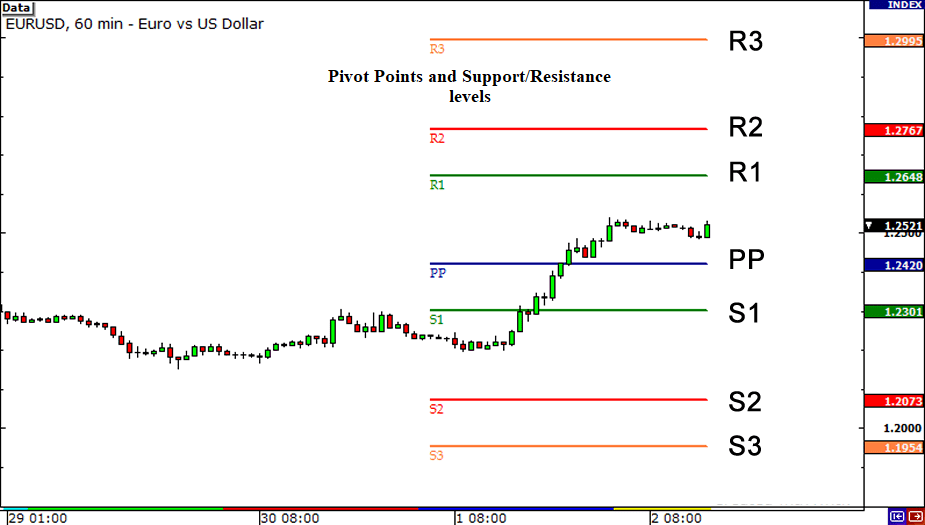Forex Trading Strategies with Pivot Points: Utilizing Pivot Points to Gauge Potential Price Movements
In the fast-paced world of Forex trading, seasoned traders are always on the lookout for effective strategies to gain an edge in the markets. One such strategy that has gained popularity is utilizing pivot points to gauge potential price movements. Pivot points serve as significant indicators, providing valuable insights into market trends and potential turning points. In this article, we will delve into the concept of pivot points, explore their calculation, and understand how to incorporate them into your trading strategy.

Table Content
1. What are Pivot Points?
2. Calculating Pivot Points
3. How to Use Pivot Points for Forex Trading
4. Creating a Pivot Point-Based Forex Trading Strategy
5. Footnote
6. Frequently Asked Questions
What are Pivot Points?
Pivot points are technical indicators used to analyze price movements in financial markets, including the Forex market. They are calculated based on the high, low, and closing prices of the previous trading day. Pivot points act as reference levels, helping traders identify potential support and resistance areas.
Calculating Pivot Points
The standard method of calculating pivot points involves the following key levels:
H1: High Price of the Previous Day
L1: Low Price of the Previous Day
C1: Closing Price of the Previous Day
With these values, you can calculate the main pivot point (PP) and additional support and resistance levels as follows:
H2: PP + (H1 - L1)
L2: PP - (H1 - L1)
H3: PP + 2 * (H1 - L1)
L3: PP - 2 * (H1 - L1)
How to Use Pivot Points for Forex Trading
1: Identifying Key Levels
Pivot points act as crucial levels that can signal potential price movements. When the price is trading above the pivot point, it indicates a bullish sentiment, while trading below signals bearishness.
2: Finding Support and Resistance
The support and resistance levels calculated from pivot points help traders determine optimal entry and exit points. A bounce from a support level may indicate a buying opportunity, while a rejection from a resistance level may signal a selling opportunity.
3: Pivot Points in Conjunction with Other Indicators
To enhance the accuracy of pivot points, traders often use them in combination with other technical indicators like moving averages, RSI, or Fibonacci retracement levels. This confluence of signals provides a more comprehensive analysis.
Creating a Pivot Point-Based Forex Trading Strategy
1: Identify the Current Trend
Analyze the overall trend in the Forex market using various timeframes. Understanding the dominant trend will help you align your trades with the market direction.
2: Calculate Pivot Points Daily
Compute pivot points and associated support and resistance levels at the start of each trading day. This practice will keep you updated on potential price levels.
3: Monitor Price Action
Observe how price reacts to pivot points and their corresponding support and resistance levels. Look for confirmation through candlestick patterns or other technical indicators.
4: Set Entry and Exit Points
Based on the analysis, set precise entry and exit points for your trades. Utilize stop-loss orders to manage risk effectively.
Footnote
In summary, pivot points are valuable tools that can significantly enhance your Forex trading strategy. By understanding how to calculate and use these levels effectively, you can gain insights into potential price movements and make more informed trading decisions. Remember to consider pivot points in conjunction with other technical indicators for a comprehensive analysis. Happy trading!
Frequently Asked Questions
Q1: Are pivot points suitable for all trading instruments?
A: Yes, pivot points can be applied to various trading instruments, including stocks, commodities, and cryptocurrencies, in addition to the Forex market.
Q2: Can pivot points be used in intraday trading?
A: Absolutely! Pivot points are particularly useful in intraday trading, as they provide short-term price targets and help traders capitalize on price swings.
Q3: Do pivot points work in a trending market?
A: Yes, pivot points can be effective in both trending and ranging markets. In trending markets, they help identify potential reversal points, while in ranging markets, they aid in spotting support and resistance levels.
Q4: How frequently should I recalculate pivot points?
A: Pivot points should be recalculated daily at the start of each trading session, as they are based on the previous day's price data.
Q5: Can pivot points be used as standalone indicators?
A: While pivot points offer valuable insights, using them alone may not be sufficient. Combining pivot points with other technical indicators can strengthen your trading strategy.











Discussion